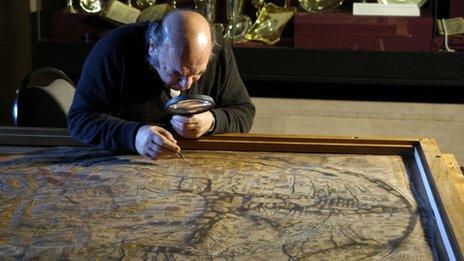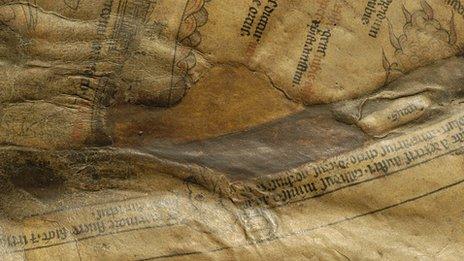Hereford's Mappa Mundi given health check
- Published

The 700-year-old map is on display in a purpose-built annex
A 700-year-old map of the world, which is one of only a handful of its kind still in existence, is being removed from display so that experts can check its condition.
The Hereford Mappa Mundi is a medieval map on a single sheet of calf skin.
It is usually exhibited in a purpose-built annex to Hereford cathedral which has its own climate control system.
Dr Christopher Clarkson, the cathedral's conservation consultant, will look for signs of deterioration.
The conditions the Mappa Mundi are kept in are carefully regulated, according to Dr Rosemary Firmin, the librarian at Hereford Cathedral.

The world map, with Jerusalem at the centre, is 900 years old
"Because it's drawn on organic material it is very susceptible to changes in the relative humidity and if the humidity drops it can become brittle," she said.
"The light levels are kept purposefully low because light is an enemy of the pigments that the map is drawn with."
She said the map's condition was monitored "very carefully" so that if changes started to happen the cathedral could take action "before it's too late".
The climate control system in the Mappa Mundi annex maintains a year-round temperature range of 16-18C (61-64F) and a relative humidity of about 50%.
The Hereford Mappa Mundi shows how "thirteenth century scholars interpreted the world in spiritual as well as geographical terms", according to the cathedral's website.
The circular map is 52in (132cm) in diameter and shows a medieval view of the world with Jerusalem at the centre.
It also has an unusual orientation to modern eyes - with east at the top and west at the bottom.
Paradise is shown on the map, surrounded by a wall and a ring of fire, roughly where Japan would be.
The garden of Eden is also shown at the edge of the world.
The map also shows more than 500 images from nature, history and classical mythology.
These include about 420 cities and towns, 15 Biblical events, 33 plants, animals, birds and strange creatures, 32 images of the people from around the world and eight pictures from classical mythology.
The map, which has been dated to about 1300, features the name of its author Richard of Haldingham or Lafford.
Dominic Harbour from the cathedral said Richard was a Prebend of Lincoln Cathedral who would have overseen the design and drawing of the map.

Parts of the map have been damaged and patched in the past
He said the map was drawn on a backboard of oak which was felled locally in 1265 which means the map was "probably always destined for Hereford".
The only other Mappa Mundi of comparable size was the Ebstorf Map, which was destroyed in 1942 during the bombing of Hanover.
Mr Harbour said the map was now the largest surviving example, and one of "only a handful" still intact.
The map hung for many years on a wall in the cathedral and the British Museum carried out restoration work in 1855.
Dr Firmin said the map had "not always lived in ideal conditions".
"The evidence of its life is there on it, there are little cracks and bumps and worn patches, and it has been patched in the past.
"It's in very good condition, though when you look at it closely you can see all kinds of imperfections."
The Mappa Mundi and Chained Library Exhibition at Hereford Cathedral will close for the first three weeks of January so that the work can take place.
- Published29 March 2011
- Published4 October 2010